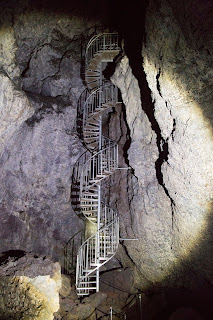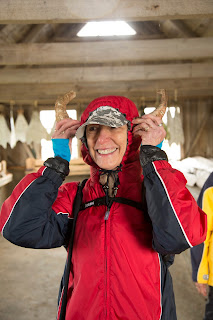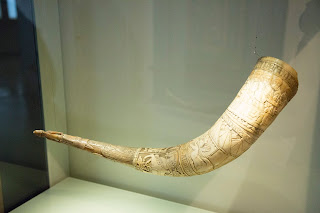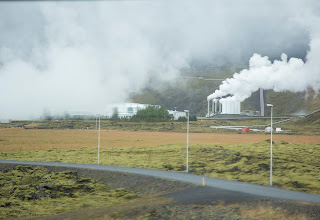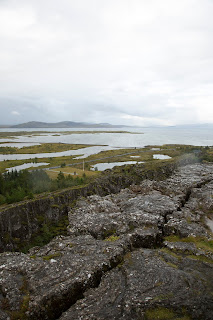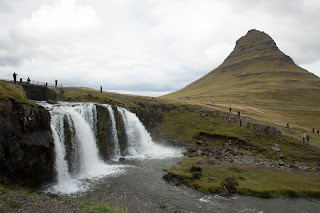We
briefly thought the forecasters might be wrong, but the wind and rain (not as
heavy to start) continued. This morning
we had an indoor activity planned; crawling down into an 8,000 year old lava
tube, the Vatneshellir Cave.
The Snæffelsnesjokull
(glacier) sits atop a 5,400 ft mountain, the tallest in Iceland within Snæffelsnesjokull National Park.
During prior volcanic eruptions, rivers of
lava flowed to the ocean. As the surface
lava cooled, it solidified with molten lava flowing beneath it until the source
was expended. At that point, a hollow
tube remained. We walked through similar
tubes in Hawaii (and will again in January).
We descended a 100 ft. spiral staircase to the depth of the tube wearing
lights and climbing helmets.
Good thing
since I whacked my head several times on the jagged walls. We spent about 45 minutes exploring the
caves. At one point, we all turned out
our lights. You couldn’t see your hand
on your nose. Really dark!
 |
| Arctic fox remains. rapped in cave |
We
came back to the surface, and the rain had stopped for now. We had tried to find the visitor’s center
before the cave tour, but the road signs told us it was 2 km to the visitor’s
center and we went much more than this (including exiting the N.P). We came to find out that the national park
never told the sign people they moved!
Finally found a nice new center with good exhibits, and a short hike to
the rocket-shaped lighthouse at Malaria
along the cliffs above the black sand
beach and the ocean.
The wind was whipping up some great swells that crashed on the rocks.
Not far from here was a really cool rock formation, the pillars of Londragar. Local myth claims that the elves use these lava formations as a church. There was also a cabin with whale ribs adorning the exterior.
The wind was whipping up some great swells that crashed on the rocks.
Not far from here was a really cool rock formation, the pillars of Londragar. Local myth claims that the elves use these lava formations as a church. There was also a cabin with whale ribs adorning the exterior.
As we left the Visitor’s Center the rain started up again
in earnest. The cold, wind, and rain
made us elect to not attempt any additional outdoor activities today (we had
hoped to ride Icelandic horses-as long as they didn’t have any Donald Trump
look-alikes, but the weather saved us), but rather hit a museum. We opted for the Icelandic National Museum on
the University of Iceland campus. The
museum is quite new and tells the story of Iceland from early settlement to
today. It was very well done, and we now
are experts in Icelandic history (but still can’t pronounce any of the
language).
Our hotel for the last night was strategically placed
about 2 miles from the airport and right on the harbor at Keflavik.
We had one last great dinner in Iceland at a seafood and Indian restaurant. The chef is Indian, so they had a full Indian menu, and fantastic seafood. We shared a seafood mixed grill appetizer and cod tikka masala, then all had monkfish with langoustines and a light curry sauce.
We had one last great dinner in Iceland at a seafood and Indian restaurant. The chef is Indian, so they had a full Indian menu, and fantastic seafood. We shared a seafood mixed grill appetizer and cod tikka masala, then all had monkfish with langoustines and a light curry sauce.
Up tomorrow early for our flight home.
Some final thoughts and observations about Iceland:
1.
People
very friendly and helpful
2.
Without a doubt, the best tap water anywhere
in the world (that we’ve been to)
3.
Weather is highly changeable. Sunny one minute, raining the next.
4.
Hiking trails in the national parks are
superbly maintained.
5.
Never saw any litter, anywhere (I guess it
helps to have a population 1/3 the size of Vermont in an area the size of
Virginia)
6.
Every public restroom was immaculate.
7.
If you drive there, get a 4-wheel drive
vehicle with adequate clearance. Subaru
Outback was fine, but if you want to drive on some of the mountain roads (like
the road to Laki), you should consider something like a Land Rover. Many of the gravel roads go through streams
and the depth can vary. More clearance ,
better chance of not getting stuck.
8.
There is good cell service nearly
everywhere. Recommend getting a GPS and
mobile hot spot for your vehicle. Mobile
hot spots have unlimited use. Most
hotels have decent WIFI.
9.
The airport is fairly small and easy to get
in and out of. There is a hotel (Hotel Smari,
a.k.a. the Aurora Star) that is a 5 minute walk from the airport if you arrive
late at night. Otherwise, the hotel we stayed at on our last night is less
expensive, nicer, and a 10 minute drive.
10.
There is a gas station on Rt. 45 just before
rental car return.
11.
Make sure you have credit cards with chips
and preferably with a PIN. Most places take Visa, MC, and Amex (a few don’t
take AMEX). Don’t really need much cash Some gas stations require a PIN with
the credit card to pay outside. If you
are stuck, you can buy a gas card and put on it any denomination of Icelandic Kroners. You then use it as a debit card until it is
exhausted.
12.
There a stores called Vinbud which are liquor
stores. Some have better wine selections
than others. Also the groceries are
great with pretty good variety (Netto).
13.
You can see Northern Lights in the fall, winter
and spring (we didn’t due to weather, but we met others who did). There is a website that can predict the
likelihood of seeing the Aurora Borealis.
It increases about 3 days after a solar flare, so as long as the weather
is clear, you have a good shot.
14.
In the past 2 years tourism has skyrocketed.
The infrastructure, especially outside of Reykjavik, hasn’t caught up. Most nicer hotels are in the 3-star category.
Also, there are not large numbers of restaurants to choose from. But the food was, overall, excellent.
15.
Everywhere the dress was hiker casual. I would leave the tux and evening dress at
home.
16.
Most of the major tourist sites are easily
accessed by car and usually a short walk.
To get to some of the less travelled areas requires some degree of
hiking.
17.
If you are going to do anything other than
minimal walking, I would recommend a good sturdy hiking boot. I wore my
lightweight low hikers, and could feel every single rock underfoot. Lava is everywhere, and it tends to be quite
jagged. I wished I had my sturdy leather Asolos.



